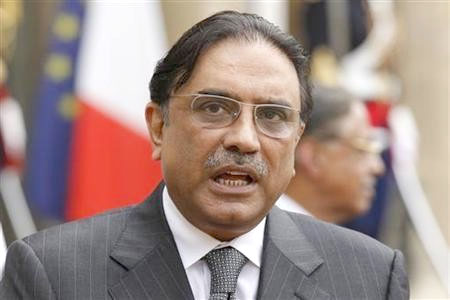India’s atomic test in May of 1974 produced tremendous concern, inciting Pakistan and regional nations to mix up world conclusion for South Asia being pronounced an atomic weapons free zone.
[contentblock id=2 img=gcb.png]
Over ensuing years, Pakistan made different proposition went for keeping the region which had as of now seen more than its offer of contentions safe from this scourge. India, in any case, disregarded these activities. Therefore, Pakistan started its own system and succeeded in imitating India when the last did crisp tests in May 1998. And one month after these the joint statement was given by UN Security Council’s permanent members and put forth the five conditions.

“Strategic Restraint Regime” was one of them. But then, Pakistan did not left any desires for dealing with this “scourge”, offering to India the Strategic Restraint Regime, containing three interlocking components of atomic restriction, settlement of disputes along with the conventional balance. To Pakistan’s disappointment, this exhaustive proposition has neglected to bring out any reaction from its neighbor. While the benefits of Indian approach could be talked about, the disposition of numerous significant forces keeps on baffling Pakistanis and others keen on controlling nuclear expansion in South Asia. The sole target of the SRR was to stay away from any atomic disaster in Subcontinent, even accidently, which must be guaranteed through atomic restriction. Theoretically, SRR would wipe out the likelihood of a arms race and, by means of dispute settlement, excuse the interests in their militaries that India and Pakistan have regarded fundamental. Truly, India has never been keen on SRR. India has at the end of the day developed as the world’s biggest arms buyer and the most recent report of Stockholm International Peace Research Institute (SIPRI) uncovers that India is world’s top arms importer, with 14% worldwide arms imports. The SRR has stayed on the table from that point forward and, most as of late has been reoffered to India in the current Nuclear and Conventional CBMs talks that started in 2004. India has reliably rejected Pakistan’s SRR. Nor have the Western nations since 1998 showed any enthusiasm for, or support for, this administration.
[contentblock id=1 img=adsense.png]
Despite what might be expected, the Western nations and Russia keep on building up India’s key capacities in both fields of atomic and conventional. Huge conventional arms deals rule the reciprocal motivation of the significant Western forces and Russia with India. On the atomic side, the US-India atomic deal, intensified further by the exclusion that undermines the NPT given to India by the NSG, and took after by liberal respective atomic agreements for atomic innovation and uranium supplies, exhibits that as opposed to atomic limitation, atomic permit is the Western target for a blend of reasons business and geo-strategic. The India-US joint agreement issued amid President Barack Obama’s recent visit to India visualizes India’s initial participation in the Nuclear Suppliers Group (NSG), a casual course of action that intends to guarantee responsible atomic exchange for peaceful purposes to avert atomic weapon expansion which reflects west’s discriminatory attitude towards Pakistan. Expectedly, Sartaj Aziz, the PM’s adviser on national security and foreign affairs, expressed accordingly that “Pakistan is against yet another nation particular exclusion from NSG guidelines to give enrollment to India, as this would facilitate intensify the officially delicate strategic stability environment in South Asia”. The US, in any case, asserts that these concessions to India serve the reason for worldwide non-proliferation.
Read More: Pakistan Pledges To Work For Easing Tension In South Asia
Pakistan’s modest atomic collaboration with China keeps on drawing negative feedback from the US, with Pakistan being blamed for taking part in atomic expansion and China of damaging its duties to the NSG. Yet, it is surely understood that Pakistan and China marked a 30-year atomic collaboration agreement in September 1986 before China joining the NSG in 2004, under whose procurements it has been occupied with building atomic reactors in Pakistan. Pakistan is persuaded that if NPT signatory states, for example, France, Russia, the UK, Japan and the US, can offer atomic technology to India, a non-NPT signatory , the US and its partners have minimal good remaining to propose that Pakistan and China abstain from comparable collaboration. The NSG’s validity has been corrupted by its separated association with these non-NPT states. The NSG specifically turned around its arrangement by allowing an exceptional nation particular exclusion to India from its trade related rules in 2008. It is settled that the US planned to utilize the NSG to propel its strategic enthusiasm to assemble India as a stabilizer against China. Since all choices in the NSG are made through mutual agreement, if India turns into a NSG part before Pakistan, it would veto Pakistan’s enrollment offer later on. Waseem Qutab in his writing suggested the criteria based NSH membership as the solution and a practical option towards the strategic stability of South Asia. The criteria-based NSG enrollment to non-NPT states can turn into a practical agreeable system to advance strategic stability in South Asia as this methodology rises above different complexities. Four convincing contentions can be made in such manner.
[contentblock id=3 img=adsense.png]
- Firstly, this criteria-based methodology can be a multilateral answer for a regional issue, which would not require any bilateral agreement in between India and Pakistan and must include other states in it as well.
- Also, both sides perceived atomic weapons as a “component of stability” in a joint proclamation issued in New Delhi in 2004. The atomic differential between two states triggers insecurity while nuclear parity restores stability and smoothness. Passing by this rationale, the India-alone NSG enrollment would disintegrate the strategic security though the criteria-based participation of India and Pakistan can possibly fix the India this and help in the restoration of nuclear and strategic stability in South Asia.
- Thirdly, the criteria-based methodology has no trap with the alleged part of non-state characters in hampering the relationship between the two states. The best strategy for both atomic states is to create counterterrorism collaboration in view of solid insight instead of enjoying useless blames.
Read More: South Asia tops in hunger
In conclusion, a criteria-based NSG participation has no suggestion for India’s distraction with China. While this remaining parts a subject of detailed study and inquiry, obviously China would welcome a joint NSG enrollment for India and Pakistan through the criteria-based methodology, which could facilitate the atomic threat between two states and encourage financial improvement and solve problems of this region. In present, South Asia is a region encircled by various issues including poverty, extremism, terrorism, territorial disputes etc. in a region like this, nuclear proliferation can cause further instability and insecurity and peace of the whole world endangered. So, the NSG can change over the hazardous issue of India’s participation into a window of opportunity to fortify the non-proliferation administration and to encourage strategic solidness in South Asia. Criteria- based approach plus the dialogues between two states can result in strategic stability of this region. Moreover, in order to solve the regional conflicts and disputes, the confidence building measures (CBM’s) are a good path to follow and gain stability and progress.
Author: Sabeen Malik












